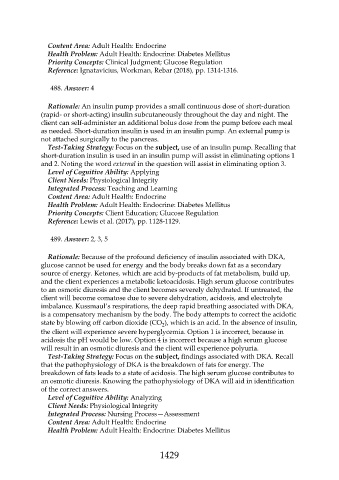Page 1429 - Saunders Comprehensive Review For NCLEX-RN
P. 1429
Content Area: Adult Health: Endocrine
Health Problem: Adult Health: Endocrine: Diabetes Mellitus
Priority Concepts: Clinical Judgment; Glucose Regulation
Reference: Ignatavicius, Workman, Rebar (2018), pp. 1314-1316.
488. Answer: 4
Rationale: An insulin pump provides a small continuous dose of short-duration
(rapid- or short-acting) insulin subcutaneously throughout the day and night. The
client can self-administer an additional bolus dose from the pump before each meal
as needed. Short-duration insulin is used in an insulin pump. An external pump is
not attached surgically to the pancreas.
Test-Taking Strategy: Focus on the subject, use of an insulin pump. Recalling that
short-duration insulin is used in an insulin pump will assist in eliminating options 1
and 2. Noting the word external in the question will assist in eliminating option 3.
Level of Cognitive Ability: Applying
Client Needs: Physiological Integrity
Integrated Process: Teaching and Learning
Content Area: Adult Health: Endocrine
Health Problem: Adult Health: Endocrine: Diabetes Mellitus
Priority Concepts: Client Education; Glucose Regulation
Reference: Lewis et al. (2017), pp. 1128-1129.
489. Answer: 2, 3, 5
Rationale: Because of the profound deficiency of insulin associated with DKA,
glucose cannot be used for energy and the body breaks down fat as a secondary
source of energy. Ketones, which are acid by-products of fat metabolism, build up,
and the client experiences a metabolic ketoacidosis. High serum glucose contributes
to an osmotic diuresis and the client becomes severely dehydrated. If untreated, the
client will become comatose due to severe dehydration, acidosis, and electrolyte
imbalance. Kussmaul’s respirations, the deep rapid breathing associated with DKA,
is a compensatory mechanism by the body. The body attempts to correct the acidotic
state by blowing off carbon dioxide (CO ), which is an acid. In the absence of insulin,
2
the client will experience severe hyperglycemia. Option 1 is incorrect, because in
acidosis the pH would be low. Option 4 is incorrect because a high serum glucose
will result in an osmotic diuresis and the client will experience polyuria.
Test-Taking Strategy: Focus on the subject, findings associated with DKA. Recall
that the pathophysiology of DKA is the breakdown of fats for energy. The
breakdown of fats leads to a state of acidosis. The high serum glucose contributes to
an osmotic diuresis. Knowing the pathophysiology of DKA will aid in identification
of the correct answers.
Level of Cognitive Ability: Analyzing
Client Needs: Physiological Integrity
Integrated Process: Nursing Process—Assessment
Content Area: Adult Health: Endocrine
Health Problem: Adult Health: Endocrine: Diabetes Mellitus
1429

